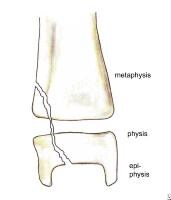

Once it has healed, the bone growth will continue normally. Type two – this fracture is also requires casting to prevent movement.Once it has healed there is no residual bone growth problems Type one – to treat this classification they will cast it to prevent any movement of the bone.Once it identified as a definite Salter-Harris fracture how it is treated depends on the age of the child and on which classification it is. Treatmentīecause a Salter-Harris fracture may take up to fourteen days to appear on an x-ray they may put a child or adolescent in a splint or cast if it suspected they have this type of fracture to prevent any further injuring to the surrounding bone and growth plate. In some cases it can take up to fourteen days before the physician can see them on an x-ray. When it is thought that the child or adolescent has a Salter-Harris fracture they will do an x-ray but at first they may not be seen on the x-ray. Abuse or assaults such as twists or hard pulls to the leg, arm, or fingers.Those involved in sports such as basketball, soccer, and football players, wrestlers, and gymnasts.The highest risk groups are teenage males. Not being able to move the injured areaĪny child who is still growing can be at risk for having a Salter-Harris fracture.Not being able to put weight on the leg.Change in the shape of the area that is different than what it normally looks like.This occurs in approximately one percent of these fractures. If it permanently injures the growth plate further treatment later may be needed to restore the alignment of the limb. This fracture can cause a severe decrease in their bone growth. Type five – when this fracture occurs their growth plate is crushed between the metaphysic and the epiphysis.This occurs in approximately ten percent of these fractures It can result in having a lasting disability. It is often associated with disrupted bone growth patterns.

Type four – the fracture starts above your growth plate then passes through it, the metaphysic, and the epiphysis, exiting through the joint cartilage.This occurs in approximately eight percent of these fractures. Because the joint cartilage has been disrupted this fracture can be concerning. Type three – the fracture passes below the growth plate and the epiphysis, exiting through the end of the bone and into the adjacent joint but not the metaphysis.This occurs in approximately seventy-five percent of these fractures and is the most common type of this fracture, especially in older children. Type two – the fracture passes above the growth plate and up through the wide portion of the long bone, called the metaphysis, but not the rounded end of the long bone at its joint, called the epiphysis.It occurs in approximately six percent of these fractures and is usually seen in younger children. Type one – the fracture passes through the growth plate but affects no other surrounding bones.Classification one through five are mainly the ones used and the last four classifications are rarely used. Using this classification system it can help to indicate if surgery will be necessary to realign the fractured bone and stabilize it. With Salter Harris fractures they are classified from one to nine according to the growth plate damage and the area of the bone that is fractured. A Salter-Harris fracture occurs most often in the lower leg or arm or the fingers. This type of fracture was first described in 1963 by Robert B.


 0 kommentar(er)
0 kommentar(er)
